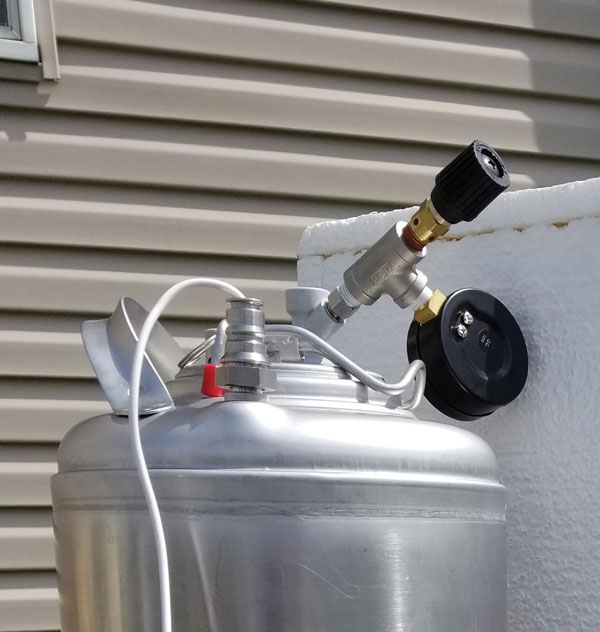Using a Corny Keg For Chilling & Primary Fermentation
TroubleShooting
Idar Hoydal — Oslo, Norway asks,
I want to ferment under pressure at 65–70 °F (18–21 °C) in a 5-gallon (19-L) Corny keg using a spunding valve set to 10–12 psi. My plan is to boil the wort, whirlpool the heck out of it to get the trub into the center of the kettle, then pump it directly into the corny keg, purge out the oxygen with CO2 and put it under light pressure. leave it to cool overnight and then pitch the yeast. Exactly what are the potential problems with this, if there are any?
There are a few possible problems with this plan, but none are insurmountable. What you are describing is something akin to coolships that were ubiquitously used by lager and ale brewers before better types of coolers were used. Even after the development of modern wort cooling using plate coolers, some lager brewers continue to use settling tanks and flotation tanks to remove cold break from wort before fermentation. I will come back to this in a moment, but want to quickly point out the issues presented by your proposed method.
Problem #1. Cooling hot wort in a closed container can lead to the conversion of SMM (S-methylmethionine), the DMS (dimethyl sulfide) precursor, into DMS. The problem with DMS is that it can lend a vegetal, cooked-corn aroma to beer, especially lighter styles with low flavor profiles brewed from lightly kilned malt that normally contains more SMM than more highly kilned malts. I think this problem is often overblown by homebrewers who read journals and textbooks targeted to commercial brewing because small batches of hot wort tend to cool below 176 °F (80 °C) relatively quickly due to the high surface-to-volume ratio of small containers.

Your closed keg of wort will likely cool below this temperature, which is considered the minimum required to convert SMM into DMS. But to err on the cautious side, consider putting your keg in a bucket of water and slowly running water into the bottom of the bucket and allowing the hot water to spill from the top. Gently rocking the keg during this process will speed things up. Monitoring the exterior surface temperature of the keg is an easy way to determine when you have cooled it enough to stop the water process and to allow the air cooling to take over.
Problem #2. Assuming that your batch size is 5 gallons (19 L), fermenting in a Corny keg is going to result in considerable beer loss because beer still foams when it ferments under pressure after equilibrium at the spunding valve set-pressure is met and excess carbon dioxide is produced. There are several options to this dilemma, including reducing the fill volume to about 4 gallons (15 L), using an anti-foaming agent like Fermcap-S, and conducting the primary fermentation in a larger fermenter and racking to the keg once the fermentation begins to slow. If using an anti-foaming agent, it is important to remove before packaging because these brewing aids do a great job of preventing beer from foaming. This can be accomplished by simply racking the beer to another vessel. However, once removed there is no residual activity and beer foam stability is not adversely affected; in fact, it is often better than in beer without anti-foam, but that’s a topic for another day.
Problem #3. The best way to remove cold-break trub is after wort cooling. Your proposed method only removes hot break from your wort in the whirlpool. Consider adding a kettle coagulant like Irish moss or a purified carrageenan from farm-raised, warm water seaweeds (e.g., Euchema cottonii) like Whirlfloc to increase the formation of cold-break material. The aforementioned settling and flotation tanks are both used to remove cold break from wort prior to pitching.
If using an anti-foaming agent, it is important to remove before packaging because these brewing aids do a great job of preventing beer from foaming.
Settling simply involves time while flotation relies on nitrogen from wort aeration to float cold trub to the wort surface where it can be skimmed or left in the tank following wort removal from the bottom. Settling works great for hot wort cooled in place while flotation should only be used following wort cooling and aeration because aerating hot wort causes wort darkening and does not dissolve sufficient oxygen for the benefit of our brewer’s yeast.
Problem #4. Your method omits wort aeration. This is not a problem if you are using dried yeast because those little critters are packed full of sterols and glycogen from how they are grown prior to drying, but liquid cultures do require wort oxygen for cell division.
Here is a proposed alternative method aimed at removing the trub:
- Add a kettle coagulant at the end of the boil to help your trub compactness when whirlpooling and to precipitate cold break during cooling.
- Transfer the wort to a carboy (plastic or glass), attach an S-style airlock, and jam a cotton plug in the open end of the airlock. Cotton plugs are very effective and inexpensive air filters and the plug will remove airborne contaminants from the air that will be pulled through the S-style airlock as the wort cools. Do not use a 3-piece airlock because this style does not prevent suck-back. What is fun is watching cold break form and settle. One reason for using a carboy is to allow for visualization of process.
- After about 8 hours, your wort should be cool and cold break should be settled in the carboy.
- Rack to your fermenter, aerate if needed, pitch yeast.
- If using something other than your Corny keg, rack from your primary to your Corny with a spunding valve set up when your fermentation is about 70% complete. There will be plenty of yeast in the fermenting beer to finish the job and the fermentation rate will have slowed to minimize foam formation and foam spittle from the spunding valve.
The other option is not to worry about removing the cold break before fermentation and to go ahead as you propose, but with a partial fill (roughly 4 gal./15 L) of your keg.

